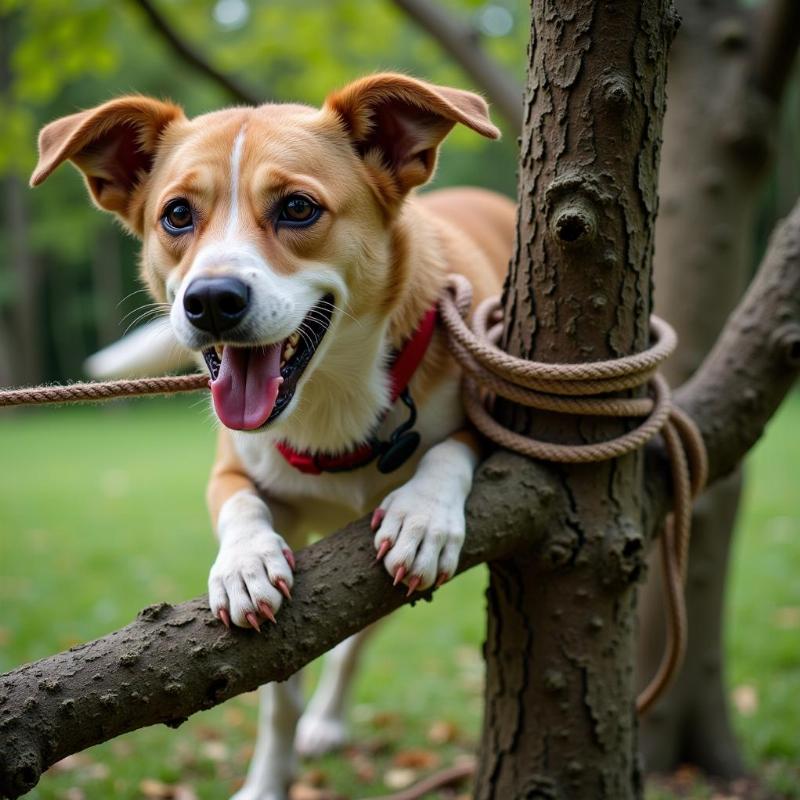Tie outs for dogs are a leashing system that allows dogs some freedom of movement outdoors while remaining restrained. They consist of a long cable or rope, typically made of metal or strong nylon, attached to a stake driven into the ground or a fixed object. While tie outs offer a convenient way to let your dog enjoy the fresh air, they should be used responsibly and with careful consideration of your dog’s safety and well-being. Understanding the proper use, potential risks, and alternatives to tie outs is essential for responsible dog ownership.
Understanding Dog Tie Outs: Uses and Considerations
A tie out can be handy in various situations, such as camping trips, picnics, or even just in your backyard when you need to keep your dog contained but don’t have a fenced area. However, it’s crucial to remember that a tie out should never be a substitute for proper exercise and interaction. Leaving a dog tied out for extended periods can lead to behavioral problems and negatively impact their overall well-being.
Are Tie Outs Safe for Dogs? Potential Risks and Hazards
While tie outs offer some convenience, they also come with potential risks. A poorly chosen or improperly used tie out can be dangerous for your dog. Tangling is a common concern, as the cable or rope can wrap around trees, furniture, or other obstacles, restricting the dog’s movement and potentially causing injury. are tie outs bad for dogs
 Dog tangled with a tie out
Dog tangled with a tie out
Another risk is injury; dogs can choke themselves if the tie out is too tight or if they become entangled. Additionally, using a chain tie out can cause chafing and skin irritation, especially in hot weather. chain tie out for dogs Lastly, leaving a dog tied out unattended can make them vulnerable to attacks from other animals or theft.
Choosing the Right Tie Out for Your Dog: Materials and Length
Selecting the appropriate tie out involves considering factors like your dog’s size, breed, and temperament. Opt for sturdy, weather-resistant materials like nylon or coated steel cables. Avoid chains as they can be heavy and uncomfortable for your dog. The length of the tie out should allow your dog ample space to move around without being able to reach hazards or escape the designated area. For smaller dogs, a shorter tie out might suffice, while larger, more active breeds may require a longer one.
Alternatives to Tie Outs: Providing Safe and Engaging Environments
Instead of relying on tie outs, explore alternative ways to provide your dog with safe and engaging outdoor experiences. A fenced yard is the ideal solution, offering your dog freedom and security. If a fence isn’t feasible, consider using a long leash and supervising your dog closely during outdoor time. can two dogs share a crate Taking your dog for regular walks and providing them with interactive toys and activities can also help satisfy their need for exercise and mental stimulation. drug sniffing dogs in schools
Conclusion: Using Tie Outs Responsibly for Dog Safety
Tie outs can be a useful tool for dog owners, but they must be used responsibly and with careful consideration of your dog’s safety and well-being. Never leave your dog tied out for extended periods, and always supervise them when they are tethered. Choose a safe and appropriate tie out material and length, and consider alternatives like fenced yards and supervised playtime with long leashes whenever possible. By prioritizing your dog’s safety and enrichment, you can ensure their outdoor experiences are both enjoyable and safe.
FAQ
-
How long can I leave my dog on a tie out? It’s best to avoid leaving your dog on a tie out for extended periods. Short durations, under close supervision, are recommended.
-
What is the best type of tie out for a dog? Nylon or coated steel cables are generally preferred over chains, as they are lighter and less likely to cause injury.
-
Are retractable tie outs safe for dogs? Retractable tie outs can pose risks if not used carefully, as they can break or cause entanglement.
-
What are some alternatives to using a tie out for my dog? Fenced yards, long leashes with supervision, and regular walks are safer alternatives to tie outs.
-
Can I use a tie out for my puppy? Puppies are particularly vulnerable to the risks associated with tie outs, so it’s generally best to avoid using them.
-
What should I do if my dog gets tangled in its tie out? Remain calm and approach your dog slowly. Carefully untangle the tie out, ensuring you don’t cause further injury.
-
Are there any legal restrictions on using dog tie outs? Some areas may have regulations regarding tie outs, so it’s important to check local ordinances.
Related Articles
Beautdogs.us is your premier source for all things dog-related in the US. We offer expert advice on dog breeds, care, and products. Whether you’re a seasoned dog owner or just starting out, Beautdogs.us is your trusted resource for comprehensive and engaging information to enhance your journey with your canine companion. Contact us at [email protected] or call us at +1 501-555-7529 for more information.